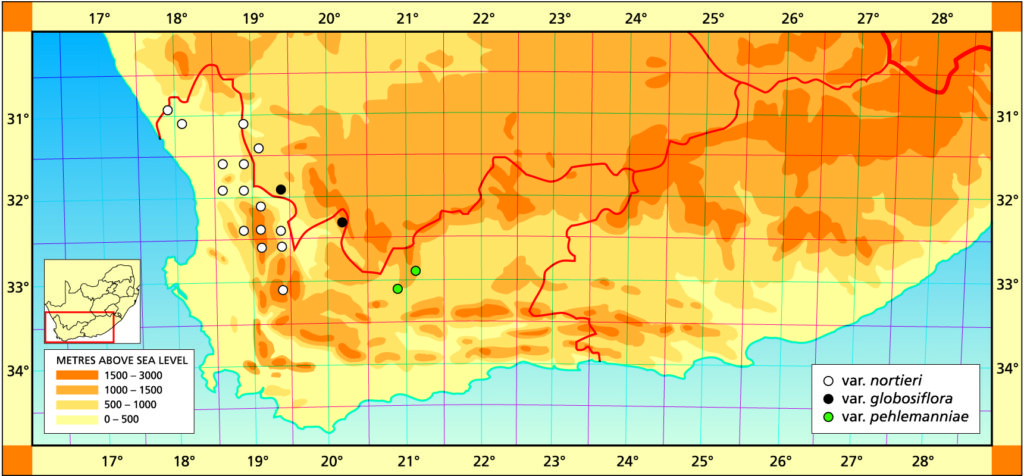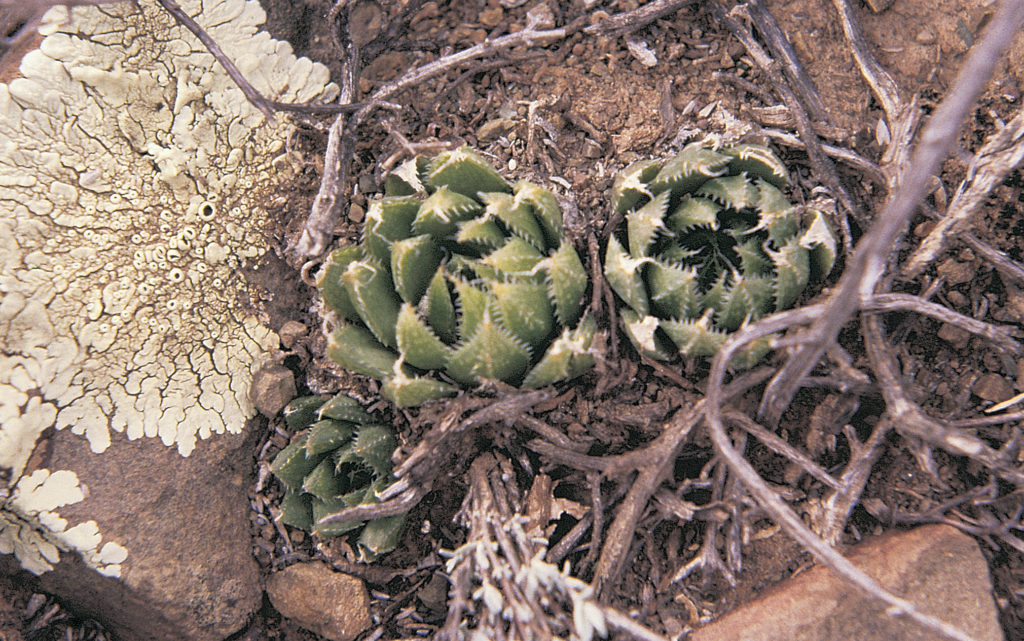25. Haworthia nortieri Smith, JS.Afr.Bot. 12:13(1946). Bayer :141(1976). Bayer :49(1982). Scott :88(1985). Type: Cape, Vanrhynsdorp, Smith 1676a (NBG): H. nortieri var. montana idem. 16:6(1950). Type: Cape, Clanwilliam, Smith 1678 (NBG): H. nortieri var. giftbergensis G.G.Sm. ibid. 16:7 (1950). Type: Cape, Vanrhynsdorp, Smith 7199 (NBG).
nortieri: for Dr. Nortier.
Rosette stemless, proliferous, 3-5cm φ. Leaves 25-45, soft sub-erect, ovate-lanceolate to obovate, pale to purplish green, with translucent spots on the leaves, small spines on margins and keel. Inflorescence slender, to 30cm. Flowers greyish-white, yellowish in tube.
1982 – H. nortieri occurs in the area between Clanwilliam and Vanrhynsdorp, extending inland to the foot of Vanrhyns Pass and on top of the plateau of the northern Cedarberg mountains. The var. globosiflora occurs in the dryer Botterkloof area and is distinguished by the flower having a globose tube while the leaves are shorter and broader. However, the flowers are not always so inflated and plants in the Vanrhyns Pass area have normal flowers while being vegetatively similar to the var. globosiflora. This is the basis for rejecting species status for the last-named. H. nortieri occupies the mid‑western geographic locale for the genus. The distribution southwards is not known and there is a big gap between this species at Pakhuis Pass (near Clanwilliam) and a form of H. archeri var. dimorpha in the Elandskloof area southeast of Citrusdal. H. arachnoidea occurs to the north of Vanrhynsdorp and also to the north and far west of Vanrhyns Pass. It does not, however, seem to appear in the Botterkloof area. H. nortieri is distinguished largely by the opaque leaf surfaces with abrupt, ovoid, pellucid spots. The flowers, and particularly the buds, are greyish in colour but the colour inside the tube is variable.
1999 – The range of H. nortieri has been extended considerably. The reference to H. archeri var. dimorpha at Elandskloof is quite erroneous and simply arises from the difficulty in relating that collection to the nearest known species. On the otherhand, the Elandskloof plants are only known to me from herbarium record and from two living plants collected by Drs Muller-Doblies. These did not seem to unequivocally be H. nortieri. P.V. Bruyns has collected H. nortieri from as far north as the Groenriver, to south as far as Kromriver in the Cedarberg. The late Harry Hall also collected it in the northeastern Knersvlakte. The most southerly collection is from near Opdieberg, north of Ceres. These plants also resemble the var. globosiflora but the flowers are not globose. At both extremes the plants tend to resemble H. globosiflora vegetatively . The plants at Komkans tend to have globose florets, and this is also true of plants at Groenriver where the florets are short and squat. The decision to include H. pehlemanniae within this species is also on account of the flower which is identical to that of var. globosiflora. This is not only in shape, but in colour too. Although the flowers may be the usual white with greenish veins, brownish-green flowers have been observed in both elements. The reference in the original description to quadrantly as opposed to spirally arranged flowers defies plant growth principles. The distribution of the two elements is complementary and gives the species as a whole an extraordinary cosmopolitan character. The colour in the flowers of the typical variety can be remarkable and as if yellow paint had been daubed at the throat of the florets. Habitat ranges from the moist south slopes of the Cedarberg to the dry wastes of Namaqualand and the so-called Moordenaarskaroo.

a. var. nortieri
The typical variety occurs over a very wide area in the Table Mountain sandstones from south-east of Citrusdal to south-west of Nieuwoudtville. In addition it extends out into the Namaqualand lowlands, into very arid conditions. It is thus a very variable taxon in its own right.
Distribution: 3017 (Hondeklipbaai): Groenriver (-DD), Bruyns 6728 (NBG). 3118(Vanrhynsdorp): Komkans (-AA), Bruyns 6146 (NBG); Klipdrif (-BB), Hall 3390 (NBG); Gifberg (-DA), Smith 7199 (BOL,NBG), Thomas in NBG626/69; Steenkampskop (-DB), Bruyns 6167 (NBG); Kobe Pass (-DB), Bruyns 6170 (NBG); Die Kom (-DC), Bayer in KG329/72 (NBG); Doornriver (-DC), Smith 1676 (NBG), Leighton (BOL); W. Doornriver (-DC), Bayer 3637 (NBG); SE. Klawer (-DC), Leipoldt 4146 (BOL), Herre in STE6695 (BOL); E. Doornriver (-DD), Smith 1676a (BOL), Smith 6212 (BOL, NBG), Esterhuysen 6008 (BOL). 3119 (Calvinia): Uitkomst (-AC), Barker 10753 (NBG); Vanrhyns Pass (-AC), Smith 6211 (NBG), Hall in NBG656/60 (NBG), Ross-Frames in NBG1200/26 (BOL). 3218 (Clanwilliam): S. Clanwilliam (-BD), Van Jaarsveld 8153 (NBG). 3219 (Wuppertal): Pakhuis Pass (-AA), Smith 1678 (NBG), ex hort Whitehill NBG68397; Waboomsriver (-AC), Henderson 2212 (NBG); Diamond Drift (-AC), Leipoldt 3107 (BOL); N. Dwarsrivier (-AC), Bruyns in Bayer 6505 (NBG); E. Dwarsriver (-AD), Bruyns in Bayer 6506 (NBG); Heksberge (-CA), Smith 6116 (NBG), Muller-Doblies 79/015 (NBG), E. Elandskloof (-CA), Esterhuysen 3987 (BOL); Sandfontein (-CB), Esterhuysen 27199a (BOL); Cedarberg (-CB), Wagener in NBG11/43 (NBG); Nuwerus (-CB), Bruyns (NBG). 3319(Worcester): NW. Ceres (-AB), Aslander 645 (NBG).

Haworthia nortieri var. nortieri JDV93/61 Pakhuis Pass. Ocuring as a solitary specimen, as seen here, or in clusters. 
Haworthia nortieri var. nortieri PVB6728 Groenriver. In this collection the flowers are very short but not globose. 
Haworthia nortieri var. nortieri JDV88/34 Klawer. A variety of the Western Cape sandstones – not penetrated by H. Arachnoidea. 
Haworthia nortieri var. nortieri JDV88/34 Klawer. The flowers are normal for the subgenus, but usually have a bright yellow throat.
b. var. globosiflora (Smith) Bayer
:119(1976). Bayer 49(1982). H. globosiflora Smith, JS.Afr.Bot. 16:11(1950). Scott :87(1985). Type: CAPE‑3119 (Calvinia): Doornbosch, N. Doorn River Bridge (‑CD), Smith 7198 (NBG).
globosiflora: rounded flowers.
This variety is not known from only the Doornbosch area south of Botterkloof, which is also relatively unexplored. It has also been collected from as far east as the Ouberg Pass, southwest of Sutherland. The illustration in Scott (:88, 1985) is not of this variety at all and is probably of H. decipiens.
Distribution: 3119 (Calvinia): Doornbosch, (‑CD), Smith 7198 (NBG); 50km N. Clanwilliam (-CD), Dyer 3750 (PRE); Botterkloof (-CD), Hall in NBG68414, Villet (BOL); Boontjiesrivier, Kansekraal (-CD), Leipoldt 4119 (BOL). 3220 (Sutherland): Ouberg Pass (-AC), Venter (NBG).

Haworthia nortieri var. globosiflora JDV93/62 Botterkloof northwest of Clanwilliam. Typically with globose flowers, there are identical forms with ordinary flowers. In the winter they often “relax” so far that they lie flat on the soil. 
Haworthia nortieri var. globosiflora JDV88/40 Ouberg Pass.This variety is in more karoid dry vegetation.
c. var. pehlemanniae (Scott) Bayer comb. nov.
H. pehlemanniae Scott, Cact.Succ.J.(U.S.) 54:70(1982). Scott :79(1085). Type: CAPE-3320 (Laingsburg): 5km W. of Laingsburg (-BB), Scott 7450 (PRE).
pehlemanniae: for Inge Pehlemann.
Since first collected, this variety has been found at several other localities in the close vicinity of Laingsburg, but also further north in the Moordenaarskaroo and north of Matjesfontein. It differs from the species in the absence of the translucent spots on the leaf, and the vegetative similarity to H. arachnoidea in the same area is deceptive. It does appear to favour shales in relatively exposed situations as opposed to H. arachnoidea which generally prefers cooler south slopes. The two taxa grow in very close association.
Distribution: 3221 (Merweville): Klipfontein, N. Laingsburg (-CC), Aslander 801 (NBG). 3320(Montagu): 5km SW. Laingsburg (-BB), Scott 7450 (PRE), Bayer 3906 (NBG); N. Laingsburg (-BB), Venter (NBG).
Inadequately located: Matjiesfontein, Pillans 830 (BOL).

Haworthia nortieri var. pehlemanniae JDV91/47 north of Laingsburg. Southwest of Laingsburg it occurs in among small sandstone boulders, whereas elsewhere it is in shales. 
Haworthia nortieri var. pehlemanniae JDV87/204 southwest of Laingsburg. Although its leaves lack the transclucent spots of var. globosiflora, the flowers are identical. 
Haworthia nortieri var. pehlemanniae JDV91/47 north of Laingsburg. Probably overlooked because of its similarity to H. arachnoidea.
